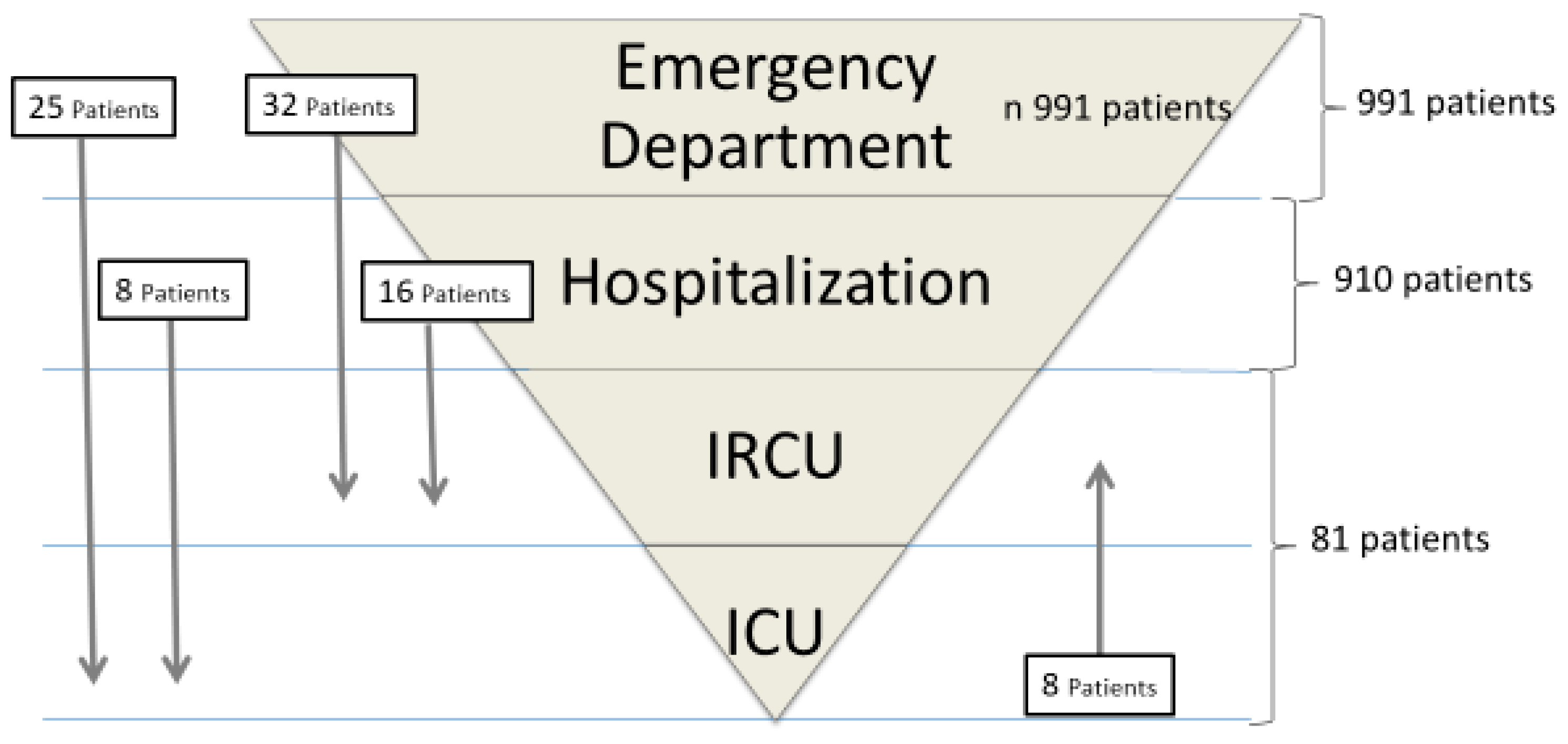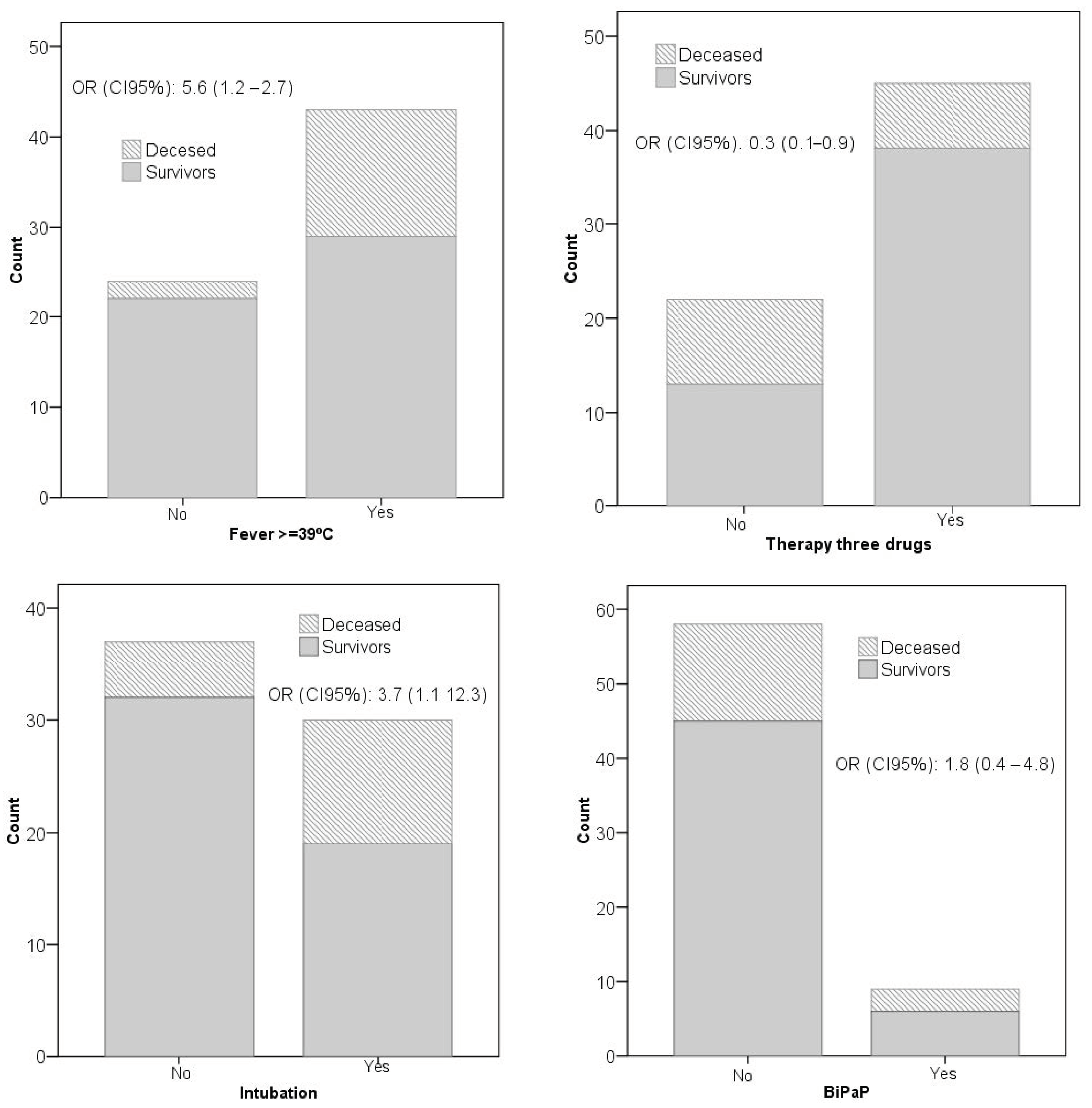Effectiveness of Intermediate Respiratory Care Units as an Alternative to Intensive Care Units during the COVID-19 Pandemic in Catalonia
Abstract
:1. Introduction
2. Methods
2.1. Definitions
2.2. Inclusion and Exclusion Criteria
2.3. Statistical Analysis
3. Results
4. Discussion
Author Contributions
Funding
Institutional Review Board Statement
Informed Consent Statement
Data Availability Statement
Acknowledgments
Conflicts of Interest
References
- Ministerio de Sanidad Consumo del Govierno de España. España. (Información Inicial Alerta). Available online: https://www.mscbs.gob.es/profesionales/saludPublica/ccayes/alertasActual/nCov/documentos/Informacion_inicial_alerta (accessed on 1 September 2021).
- Ministerio de Sanidad Consumo del Govierno de España. España. (Información Inicial Alerta), Situación Actual. Available online: https://www.mscbs.gob.es/profesionales/saludPublica/ccayes/alertasActual/nCov/situacionActual.htm (accessed on 1 September 2021).
- Ministerio de Sanidad Consumo del Govierno de España. España. (Enfermedades Transmisibles). Available online: https://www.isciii.es/QueHacemos/Servicios/VigilanciaSaludPublicaRENAVE/EnfermedadesTransmisibles (accessed on 1 September 2021).
- Li, X.; Xu, S.; Yu, M.; Wang, K.; Tao, Y.; Zhou, Y.; Shi, J.; Zhou, M.; Wu, B.; Yang, Z.; et al. Risk factors for severity and mortality in adult COVID-19 inpatients in Wuhan. J. Allergy Clin. Immunol. 2020, 146, 110–118. [Google Scholar] [CrossRef] [PubMed]
- Zhou, F.; Yu, T.; Du, R.; Fan, G.; Liu, Y.; Liu, Z.; Xiang, J.; Wang, Y.; Song, B.; Gu, X.; et al. Clinical course and risk factors for mortality of adult inpatients with COVID-19 in Wuhan, China: A retrospective cohort study. Lancet 2020, 395, 1054–1062. [Google Scholar] [CrossRef]
- Wang, D.; Yin, Y.; Hu, C.; Liu, X.; Zhang, X.; Zhou, S.; Jian, M.; Xu, H.; Prowle, J.; Hu, B.; et al. Clinical course and outcome of 107 patients infected with the novel coronavirus, SARS-CoV-2, discharged from two hospitals in Wuhan, China. Crit. Care 2020, 24, 188. [Google Scholar] [CrossRef] [PubMed]
- CDC COVID-19 Response Team; Bialek, S.; Boundy, E.; Bowen, V.; Chow, N.; Cohn, A.; Dowling, N.; Ellington, S.; Gierke, R.; Hall, A.; et al. Severe outcomes among patients with coronavirus disease 2019 (COVID-19)—United States, 12 February–16 March 2020. Morb. Mortal. Wkly. Rep. 2020, 69, 343–346. [Google Scholar]
- Covino, M.; De Matteis, G.; Santoro, M.; Sabia, L.; Simeoni, B.; Candelli, M.; Ojetti, V.; Franceschi, F. Clinical characteristics and prognostic factors in COVID-19 patients aged ≥80 years. Geriatr. Gerontol. Int. 2020, 20, 704–708. [Google Scholar] [CrossRef] [PubMed]
- Wu, Z.; McGoogan, J.M. Characteristics of and important lessons from the coronavirus disease 2019 (COVID-19) outbreak in China. JAMA 2020, 323, 1239–1242. [Google Scholar] [CrossRef] [PubMed]
- Rubio, O.; Estella, A.; Cabre, L.; Saralegui-Reta, I.; Martin, M.C.; Zapata, L.; Esquerda, M.; Ferrer, R.; Castellanos, A.; Trenado, J.; et al. Ethical recommendations for a difficult decision-making in intensive care units due to the exceptional situation of crisis by the COVID-19 pandemia: A rapid review & consensus of experts. Med. Intensiva 2020, 44, 439–445. [Google Scholar] [CrossRef] [PubMed]
- Joebges, S.; Biller-Andorno, N. Ethics guidelines on COVID-19 triage-an emerging international consensus. Crit. Care 2020, 24, 201. [Google Scholar] [CrossRef] [PubMed]
- Torres, A.; Ferrer, M.; Blanquer, J.B.; Calle, M.; Casolivé, V.; Echave, J.M.; Masa, D.M. Unidades de cuidados respiratorios intermedios. Definición y características. Arch. Bronconeumol. 2005, 41, 505–512. [Google Scholar] [CrossRef] [PubMed]
- Brochard, L.; Isabey, D.; Piquet, J.; Amaro, P.; Mancebo, J.; Messadi, A.A.; Brun-Buisson, C.; Rauss, A.; Lemaire, F.; Harf, A. Reversal of acute exacerbations of chronic obstructive lung disease by inspiratory assistance with a face mask. N. Engl. J. Med. 1990, 323, 1523–1530. [Google Scholar] [CrossRef] [PubMed]
- Sprung, C.L.; Joynt, G.M.; Christian, M.D.; Truog, R.D.; Rello, J.; Nates, J.L. Adult ICU Triage During the Coronavirus Disease 2019 Pandemic: Who Will Live and Who Will Die? Recommendations to Improve Survival. Crit. Care Med. 2020, 48, 1196–1202. [Google Scholar] [CrossRef] [PubMed]
- Burns, G.P.; Lane, N.D.; Tedd, H.M.; Deutsch, E.; Douglas, F.; West, S.D.; Macfarlane, J.G.; Wiscombe, S.; Funston, W. Improved survival following ward-based non-invasive pressure support for severe hypoxia in a cohort of frail patients with COVID-19: Retrospective analysis from a UK teaching hospital. BMJ Open Respir. Res. 2020, 7, e000621. [Google Scholar] [CrossRef] [PubMed]
- Guenancia, T.N.; Rosa, A.; Damoisel, C.; Mercier, F.J.; Jeannin, B. Implementation of a non-invasive oxygenation support strategy during the COVID-19 pandemic in an ephemeral Respiratory Intermediate Care Unit. Anaesth. Crit. Care Pain Med. 2020, 39, 459–460. [Google Scholar] [CrossRef]
- Maltese, G.; Corsonello, A.; Di Rosa, M.; Soraci, L.; Vitale, C.; Corica, F.; Lattanzio, F. Frailty and COVID-19: A Systematic Scoping Review. J. Clin. Med. 2020, 9, 2106. [Google Scholar] [CrossRef] [PubMed]
- Toner, E.; Waldhom, R. What US Hospitals Should Do Now to Prepare for a COVID-19 Pandemic; Johns Hopkins University Center for Health Security: Baltimore, MD, USA, 2020. [Google Scholar]
- Resolución de 26 de Diciembre de 2001, de la Dirección General del Instituto Nacional de la Salud, Sobre Revisión de Precios a Aplicar por los Centros Sanitarios a las Asistencias Prestadas en los Supuestos Cuyo Importe ha de Reclamarse a los Terceros Obligados al Pago o a los Usuarios sin Derecho a la Asistencia Sanitaria de la Seguridad Social, (BOE-A-2002-215). Available online: https://www.boe.es/ (accessed on 1 September 2021).
- Heili-Frades, S.; de Miguel, M.D.P.C.; Prieto, A.N.; Lozano, M.G.; García, X.M.; Fernández, I.M.; Ormaechea, I.F.; Suárez, L.Á.; de Blas, F.E.; Venegas, M.J.C.; et al. Análisis de costes de una unidad de cuidados intermedios respiratorios. ¿Es realmente eficiente y segura? Arch. Bronconeumol. 2019, 55, 634–641. [Google Scholar] [CrossRef]
- Galdeano-Lozano, M.; Alfaro-Álvarez, J.C.; Heili-Frades, S.; Parra-Macías, N.; Parra-Ordaz, O. Estudio descriptivo de la mejora de la eficiencia clínica y económica sobre el paciente ingresado en una unidad de cuidados respiratorios intermedios tras la introducción de un proceso asistencial integrado. J. Healthc. Qual. Res. 2021, 36, 211–216. [Google Scholar] [CrossRef] [PubMed]





| Clinical Variables | Mean | SD |
|---|---|---|
| Age | 65 | 12.8 |
| Barthel Score | 75 | 8.3 |
| Charlson Score | 3.1 | 2.2 |
| SOFA Score | 4.5 | 2.2 |
| Arterial Gasometry Variables | Admitted to IRCU (Mean/SD) | 3 Days after Admission to IRCU (Mean/SD) |
| pH | 7.43/0.09 | 7.43/0.13 |
| pO2 mmHg | 67.5/37.5 | 77.5/34.4 |
| pCO2 mmHg | 39.7/9.1 | 42.8/9.5 |
| Test Variables | Deceased | Survivors | p |
|---|---|---|---|
| LDH (mean [SD]) | 649 UI/L [649.7] | 327 UI/L [327.0] | 0.002 |
| K+ (mean [SD]) | 3.8 mEq/L [0.58] | 4.5 mEq/L [0.65] | 0.025 |
| ALT (mean [SD]) | 81.8 UI/L [63.0] | 38.6 UI/L [15.47] | 0.004 |
| Total bilirubin (mean [SD]) | 1.3 mg/dL [0.79] | 0.6 mg/dL [0.48] | 0.009 |
| Arterial bod gas analyis | Deceased | Survivors | p |
| PaO2 (mean [SD]) | 44.5 mmHg [25.3] | 78.9 mmHg [34.4] | 0.034 |
| PaFiO2 (mean [SD]) | 89.7 [26.3] | 147.2 [66.0] | 0.002 |
| Clinical Variables | Deceased | Survivors | p |
| HR (mean [SD]) | 97.5 lpm [20.2] | 84.2 lpm [17.187] | 0.015 |
| RR (mean [SD]) | 28.9 rpm [4.9] | 24.4 rpm [6.1] | 0.013 |
| Variables | Cost (€) | % Respect Total Cost the IRCU |
|---|---|---|
| Personnel costs | 52,020.95 | 78.54% |
| Expenses for consumption | 5272.27 | 7.96% |
| Amortization and equipment | 0 | 0 |
| Testing and radiology | 3816.00 | 5.76% |
| Pharmacy | 5124.56 | 7.73% |
| Total cost of the IRCU | 66,233.78 | 100% |
| Total cost avoided by the IRCU during two months of the pandemic for the 56 patients | 214,865.16 |
Publisher’s Note: MDPI stays neutral with regard to jurisdictional claims in published maps and institutional affiliations. |
© 2022 by the authors. Licensee MDPI, Basel, Switzerland. This article is an open access article distributed under the terms and conditions of the Creative Commons Attribution (CC BY) license (https://creativecommons.org/licenses/by/4.0/).
Share and Cite
Galdeano Lozano, M.; Alfaro Álvarez, J.C.; Parra Macías, N.; Salas Campos, R.; Heili Frades, S.; Montserrat, J.M.; Rosell Gratacós, A.; Abad Capa, J.; Parra Ordaz, O.; López Seguí, F. Effectiveness of Intermediate Respiratory Care Units as an Alternative to Intensive Care Units during the COVID-19 Pandemic in Catalonia. Int. J. Environ. Res. Public Health 2022, 19, 6034. https://doi.org/10.3390/ijerph19106034
Galdeano Lozano M, Alfaro Álvarez JC, Parra Macías N, Salas Campos R, Heili Frades S, Montserrat JM, Rosell Gratacós A, Abad Capa J, Parra Ordaz O, López Seguí F. Effectiveness of Intermediate Respiratory Care Units as an Alternative to Intensive Care Units during the COVID-19 Pandemic in Catalonia. International Journal of Environmental Research and Public Health. 2022; 19(10):6034. https://doi.org/10.3390/ijerph19106034
Chicago/Turabian StyleGaldeano Lozano, Marina, Julio César Alfaro Álvarez, Núria Parra Macías, Rosario Salas Campos, Sarah Heili Frades, Josep Maria Montserrat, Antoni Rosell Gratacós, Jorge Abad Capa, Olga Parra Ordaz, and Francesc López Seguí. 2022. "Effectiveness of Intermediate Respiratory Care Units as an Alternative to Intensive Care Units during the COVID-19 Pandemic in Catalonia" International Journal of Environmental Research and Public Health 19, no. 10: 6034. https://doi.org/10.3390/ijerph19106034
APA StyleGaldeano Lozano, M., Alfaro Álvarez, J. C., Parra Macías, N., Salas Campos, R., Heili Frades, S., Montserrat, J. M., Rosell Gratacós, A., Abad Capa, J., Parra Ordaz, O., & López Seguí, F. (2022). Effectiveness of Intermediate Respiratory Care Units as an Alternative to Intensive Care Units during the COVID-19 Pandemic in Catalonia. International Journal of Environmental Research and Public Health, 19(10), 6034. https://doi.org/10.3390/ijerph19106034






